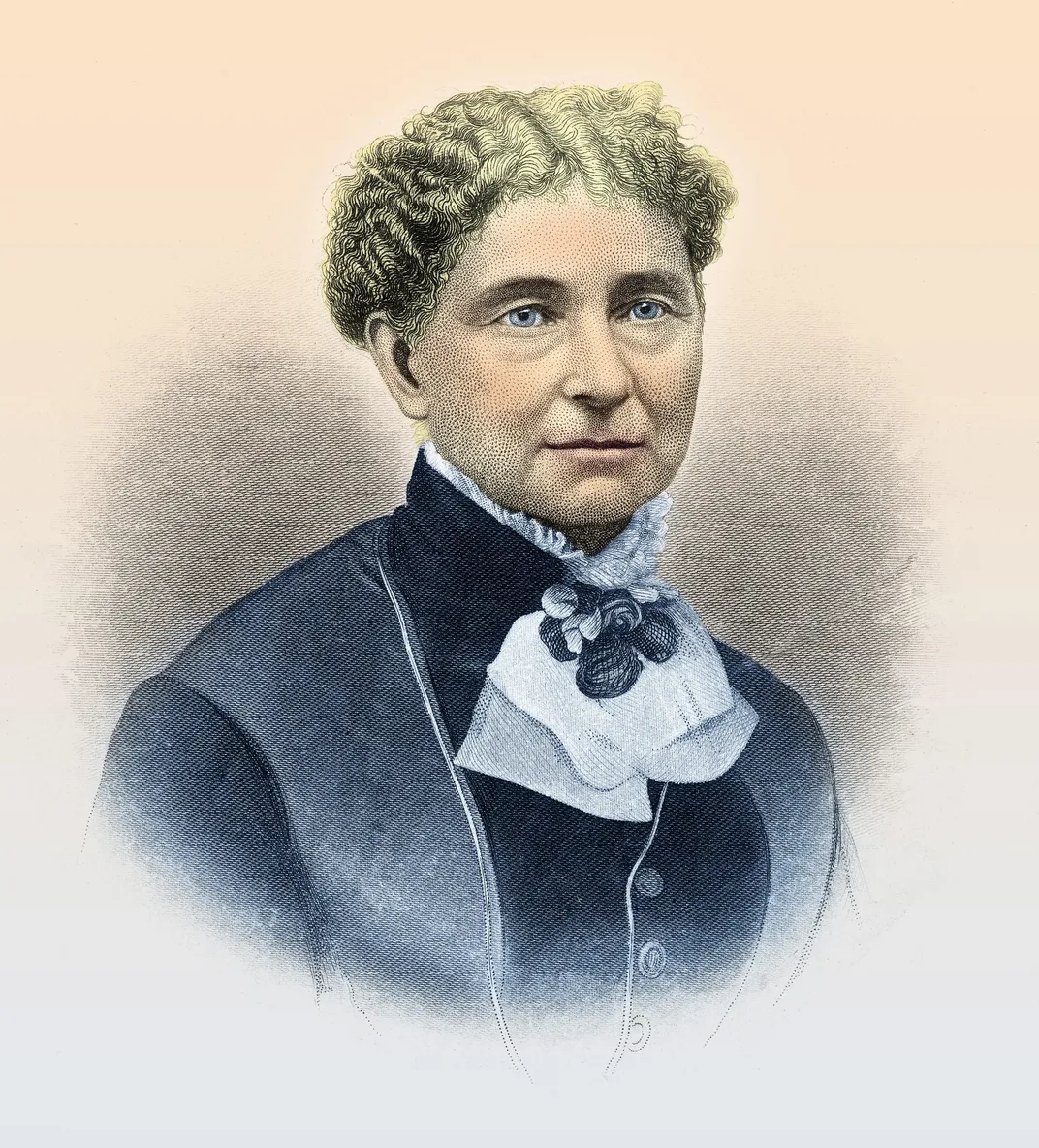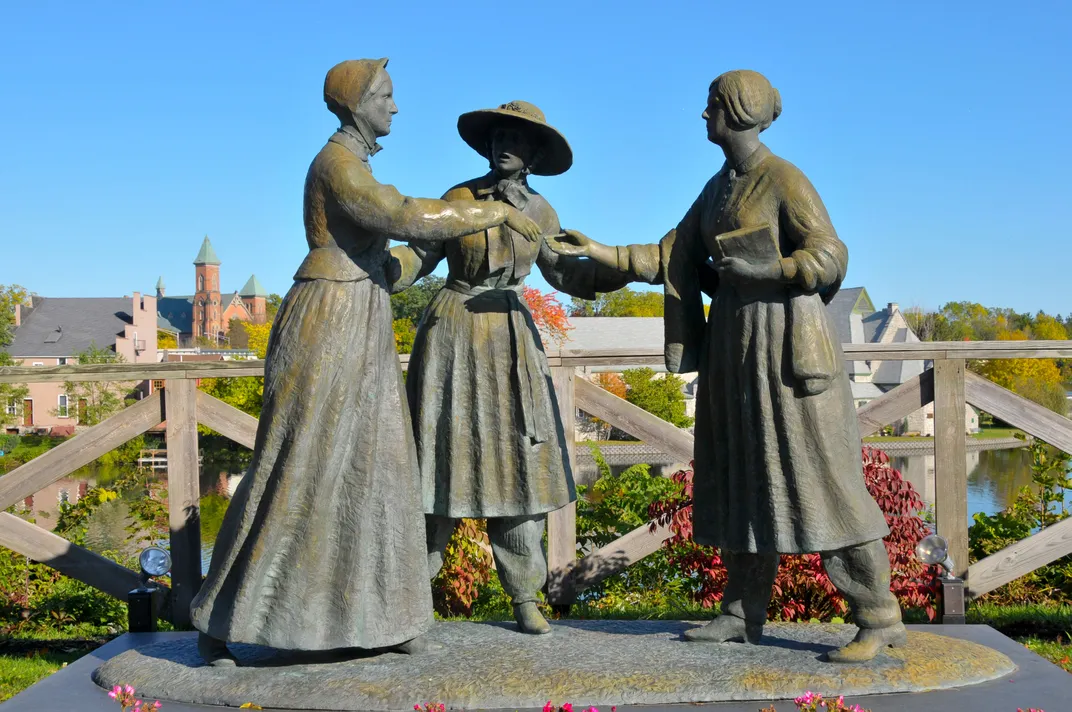Amelia Bloomer Didn’t Mean to Start a Fashion Revolution, But Her Name Became Synonymous With Trousers
In the 1850s, women’s rights activists briefly adopted a new style in an effort to liberate themselves from heavy dresses
:focal(403x45:404x46)/https://tf-cmsv2-smithsonianmag-media.s3.amazonaws.com/filer/03/cd/03cd5a1b-64ff-49fb-8456-254f5aef341b/bloomer-costume.jpg)
In mid-1800s America, everyone agreed women’s clothing posed a problem. The dictates of modesty called for floor-length dresses, and fashion demanded a full skirt beneath a tiny waist. As a result, middle- and upper-class American women squeezed themselves into corsets and six to eight petticoats to fill out the shape of their skirts. The result weighed up to 15 pounds, placed enormous pressure on their hips, and made movement a struggle.
“Women complained of overheating and impaired breathing, sweeping along filthy streets and tripping over stairs, crushed organs from whalebone stays and laced corsets, and getting caught in factory machinery,” writes historian Annemarie Strassel.
Doctors worried the outfits might cause health problems for pregnant mothers, and the press regularly lampooned the style of the day, with cartoons showing assorted garbage getting caught in women’s sweeping skirts. But what could be done?
An editor of the Seneca County Courier had one idea: maybe women could avoid the discomfort and dangers of their attire by switching to “Turkish pantaloons and a skirt reaching a little below the knee.”
The editorial, written in February 1851 by a man who had previously opposed the women’s suffrage movement and the 1848 Seneca Falls Convention, drew the attention of one feminist. Amelia Bloomer was herself an editor of the first women’s newspaper, The Lily. She used her paper to gently upbraid the Seneca County Courier writer for supporting dress reform, but not women’s rights.
At almost exactly the same time, Bloomer’s neighbor, suffragist Elizabeth Cady Stanton, received a visit from her cousin, Elizabeth Smith Miller—who was wearing the very outfit Bloomer had just been discussing in the press. Alternately called “Turkish trousers” or “pantaloons,” the outfit combined knee-length skirts with loose pants. Stanton exclaimed over the style and made herself up in the same way. Bloomer wasn’t far behind, feeling that it was her duty to do so, as she’d engaged in the question of women’s dress in the media, and announced her decision to her readers in the April 1851 edition of The Lily.

In no time at all, the new dress seemed to set the entire media world aflame. “I stood amazed at the furor I had unwittingly caused,” Bloomer later wrote. “Some praised and some blamed, some commented, and some ridiculed and condemned.” But what journalists had to say mattered little to Bloomer’s audience. After Bloomer included a print of herself in the reform dress in The Lily, hundreds of letters poured into her office.
“As soon as it became known that I was wearing the new dress, letters came pouring in upon me by hundreds from women all over the country making inquiries about the dress and asking for patterns—showing how ready and anxious women were to throw off the burden of long, heavy skirts,” she wrote. Soon after the dress controversy erupted, The Lily’s circulation rose from 500 per month to 4,000. And with the explosion of interest, Bloomer’s name was soon inextricably tied to the trend, despite her protesting that she wasn’t the originator of the style. Soon adopters of the new look were “Bloomerites” or practitioners of “Bloomerism,” or, more simply, wearing “Bloomers.”
But it wasn’t long before the tide of public opinion turned from bemused comments to vitriolic ones. “[The women] experienced a lot of harassment,” says Amy Kesselman, a scholar in women’s gender and sexuality studies at SUNY New Paltz. “To us, it doesn’t look like a radical thing, but wearing pants was a kind of flag of gender dissent.”
Activist Angelina Grimke expressed her irritation at the level of disapproval, writing, “If the Bloomer costume had come from a Paris milliner it would have been welcomed in Boston, New York and Philadelphia, but as it is the only dress which has ever been adopted from principle, from a desire in woman to fit herself for daily duty—as it is the out-birth of a state of mind which soars above the prevalent idea of the uses of woman, therefore it shocks the taste.”
For several years, the women’s rights activists endured the public censure for the freedom of mobility the new outfit provided. Stanton professed she felt “like a captive set free from his ball and chain” while Bloomer praised the lightness and comfort of the outfit. But as the pressure continued on all sides, suffragists gradually returned to the old style—now made more palatable by the invention of crinoline, a fabric encircled by light wire to create the bell effect that had once only been possible with layers of petticoats.

Bloomer continued wearing the outfit for several more years, as she moved from upstate New York to Ohio in 1853, and then on to Iowa in 1855. Eventually, though, she too returned to the old style of full-length skirts. “We all felt that the dress was drawing attention from what we thought of far greater importance—the question of woman’s right to better education, to a wider field of employment, to better remuneration for her labor, and to the ballot for the protection of her rights,” Bloomer wrote. “In the minds of some people, the short dress and woman’s rights were inseparably connected. With us, the dress was but an incident, and we were not willing to sacrifice greater questions to it.”
While the struggle for dress reform was carried on by smaller groups of women and certain health practitioners, it generally faded away from the stated goals of activists like Bloomer, Stanton and Susan B. Anthony. But the association between pants and women’s rights never quite faded, even to this day, says Salem State University historian Gayle Fischer.
“If you wanted something that’s continued from 1851 and Amelia Bloomer to the present, it would be the response of people to women in trousers,” Fischer says. “And perhaps even more narrowly, the response to women who try to enter the political arena while wearing trousers.” Just look at the number of stories written about Hillary Clinton’s pantsuits. For Fischer, the explanation for this obsession is simple: “We’re still not comfortable with the idea of women having this kind of masculine power.”
But today, at least, most people don’t have any problem with women wearing jeans. And for that, we can thank Bloomer and others like her, who first braved harassment in their search for more comfortable clothes.
/https://tf-cmsv2-smithsonianmag-media.s3.amazonaws.com/accounts/headshot/lorraine.png)
/https://tf-cmsv2-smithsonianmag-media.s3.amazonaws.com/accounts/headshot/lorraine.png)